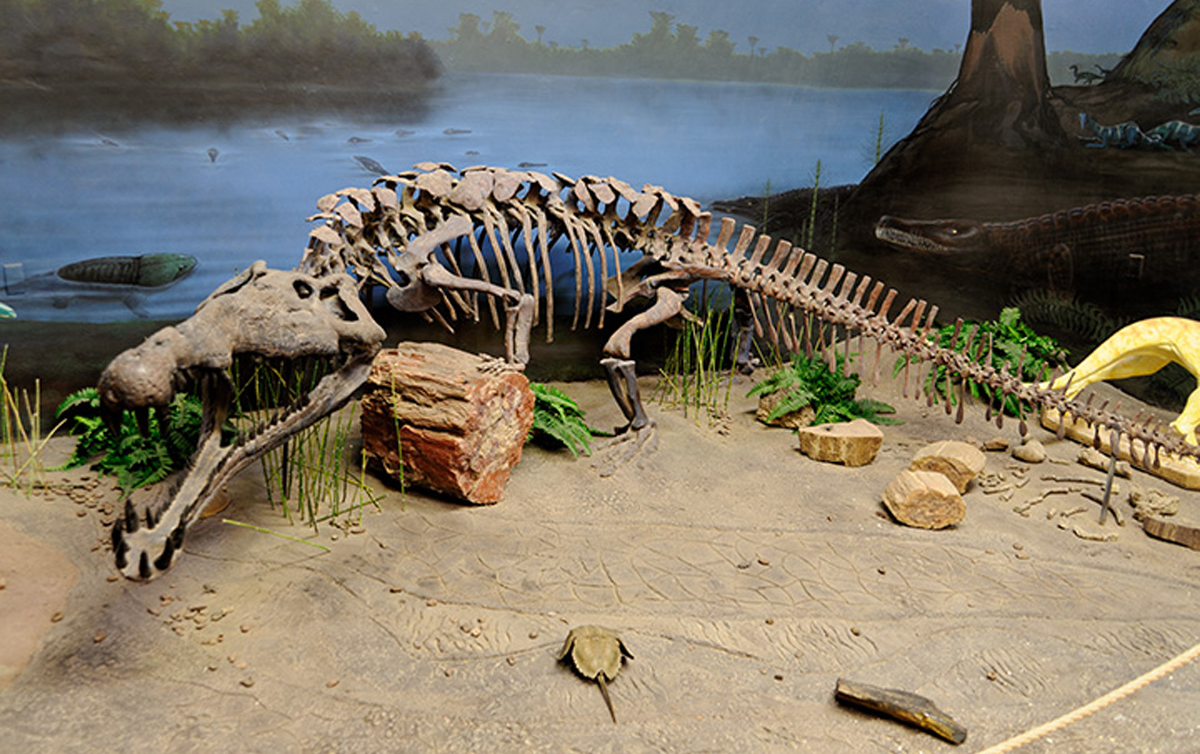
Utah Diné Bikéyah cites creation narratives as further justification for protecting Bears Ears Triassic-Era phytosaur fossil resources
By Alastair Lee Bitsóí
Mark Maryboy, a board member for Utah Diné Bikéyah, says the recent discovery of phytosaur fossils in Bears Ears National Monument highlights another essential resource that is intimately tied to the native wisdom, and in this case Navajo creation narratives.
Kevin Madalena, a cultural resource coordinator for Utah Diné Bikéyah, adds that the Ancient Ones were aware of Triassic-era fossils, dinosaurs and the remains of other creatures like it, as indicated by historic mammoth petroglyphs recorded at various ancestral Puebloan ruins.
These tribal connections around fossils and nearly every other natural resource at Bears Ears include stories, wisdom, and cultural teachings that we as tribal members have rarely shared with the public or the mainstream media. Utah Diné Bikéyah aims to show the benefits and legacy of Native oral history that showcases the diversity, intelligence, and complexity of thought that these lessons hold. Dinosaurs and paleontology have shaped southwestern Native American views of the world.
Recent media stories explained how the phytosaur and other creatures that lived in the Triassic, Jurassic, and Cretaceous periods are informing our scientific understanding of how “Mother Nature did experiments with life” and called it one of the world’s richest collections of Triassic-era fossils. According to Rob Gay, the paleontologist with Colorado Canyons Association who discovered the fossil, the phytosaur closely resembles modern crocodiles and is part of the Chinle Formation.
In the Navajo creation stories, the phytosaur was most likely living during the Third World among other “monsters.” The Third World, or Yellow World, is when the Hero Twins, deities in the Navajo universe, fought these monsters that wreaked havoc on Mother Earth’s many lifeforms. These Navajo “Hero Twins” made the world habitable by defeating most all of the monsters who roamed across DineTah (Navajo Territory), turned them into fossils, and buried their blood and organs deep in the earth (some think this is oil, gas, uranium and other minerals that will wreak havoc again if dug up). The physical evidence of these fossils that dot the landscape, combined with the life lessons of these teachings, shapes who Navajo people are today.
Some evidence of these notorious monsters still exists in Navajo territory, such as the huge bird that lived on Shiprock, a fossil bed in Red Mesa, Ariz., and dinosaur tracks near Tuba City, Ariz., all of which were killed by the Hero Twins and the weapons they secured from their father, the Sun.
“The monsters have been here since the First World,” explained Maryboy, who is also a Navajo cultural practitioner. “But, in the Third World, they became so big!”
Maryboy explained that the Hero Twins and other living beings in Third World had to listen to the universe and relied on astronomy for information to defeat these monsters. Such modern examples among Navajo people today are the use of stargazers to help heal patients back into a harmonious state with nature, or Hozho.
During this primordial time, as the Hero Twins slayed these monsters, ceremonies with guidance from Navajo deities were created to protect and cleanse the spirit of the twins. This is where ceremonies like the Enemy Way emerged, Maryboy said, alluding to the association of how Navajo ceremonies were created to fight monsters, possibly like the phytosaur, before Navajos emerged as a people into the current Glittering Fourth World and continue to exercise these ceremonies today.
“A lot of what I am telling you is lost on the public. There are very few of us that know this knowledge,” Maryboy said, adding that the texts “Sharing the Skies: Navajo Astronomy” and “The Book of the Navajo” are sources that verify his claim. Yet, at the same time, every Navajo child is taught lessons derived from these teachings.
According to Madalena, the era in which the Tyrannosaurs lived and when humans emerged is determined by the creator, or intellectual designer of the universe.
“Right now, it’s our turn to live. We were not meant to live during a T-Rex era,” explained Madalena, who is Jemez Pueblo and a trained paleontologist. “We have proof at the Bears Ears National Monument that ruins have Fremont Age 1 and Basketmaker II construction, with some of the kivas intentionally included Theropod fossils hauled from great distances and inserted as hearths or decorations in prominent locations in the home. Fossils are important to who we are. We know that old Puebloans drew mammoths being hunted. They knew of the larger animals long after they existed. The depictions in petroglyphs come close to what we see in the modern dinosaurs at collections in museums.”
Madalena added the phytosaur discovery is an important piece of data and could help us understand climate change, particularly when the U.S. military has recently asked paleontologists and geologists about how to prepare for climatic threats. Similar threats to what we are experiencing today may have caused mass extinctions during other time periods.
“All that data is irreplaceable,” he said, referring to how the Trump Administration’s recent approval for Energy Fuels, Inc. to begin mining at the Danero’s Mine further disrupts tribal connections to Bears Ears.
Madalena previously worked with Gay as a member of the Bureau of Land Management and collaborated with Adrienne Mayor on “Fossil Legends of the First Americans.”
“As earth historians, we need to look at the data on earth before humans were here,” added Madalena. “That’s why it’s absolutely imperative that we protect Bears Ears National Monument and Grand Staircase-Escalante National Monument. You cannot use an algorithm to construct environmental models out of thin air. The extraction of energy resources should always be weighed against the values that may be destroyed in the process, and in the case of Bears Ears Native wisdom should be given a chance to teach us what we know.”
Alastair Lee Bitsóí is communications coordinator for Utah Diné Bikéyah.



